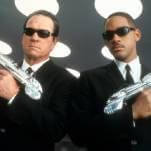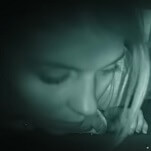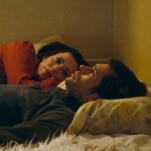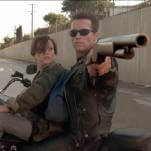When Tom Holland began his career in film, he took whatever jobs he could get, working as a grip, loader, and PA, among other small-time gigs. He also trained as an actor at the Actors Studio under Lee Strasberg before eventually finding his niche in screenwriting. Throughout the early ’80s, Holland gained steam as a genre scribe, writing the cult classics The Beast Within and Class Of 1984, as well as the first sequel to Alfred Hitchcock’s proto-slasher Psycho. While writing the family action/adventure Cloak & Dagger, Holland came up with the concept for his directorial debut, Fright Night.
August 2 marked the 30th anniversary of Holland’s vampire-next-door horror-comedy. Fright Night was a surprise hit, eventually becoming the second-highest-grossing horror film of 1985, outpaced only by Freddy Krueger. The film spawned a sequel, a remake, and a sequel to the remake, as well as a ’80s comic-book series. Now, the team that put together the massive documentary Leviathan: The Story Of Hellraiser And Hellbound: Hellraiser II is producing You’re So Cool, Brewster: The Story Of Fright Night, which will feature the cast and crew reflecting on the legacy of Evil Ed and friends. The A.V. Club sat down with the creator of Jerry Dandridge—as well as everyone’s friend to the end, Good Guy doll Chucky—to delve into the writing process, horror fandom, sequels, and his love of practical special effects.
TH: Well I admired Brad for Terminator, but that was at a moment when electronic music really broke to the forefront. Now we had heard it before with Tangerine Dream in Sorcerer, the remake of Wages Of Fear. That was the first time I heard electronic music and after that I really started paying attention. That seemed like a way of modernizing a score, and I was consciously doing an updating of the vampire genre within a fan context. One of the ways to do that was to use electronic music, and I thought that Brad Fiedel’s score for Terminator was just wonderful.
AVC: How much input did you have on the Fright Night soundtrack? It’s an interesting collection of artists: Sparks, Devo, Evelyn “Champagne” King, J. Geils Band, Ian Hunter…
TH: I had a music supervisor with whom I was close, David Chackler. I wrote that script with needle drops, places for the music to go in. David had what I thought was an original idea, a great idea, which was that he would have original songs written for the movie that would reflect what would be going on in the scenes. We went through the artists, some of them I knew and some of them I didn’t. I approved them, but I relied on his judgment. All those songs on that soundtrack were written for the movie.
AVC: Were you a fan of horror growing up?
TH: That’s what Fright Night is. It’s a love letter to fans everywhere, because that was me.
AVC: Charley Brewster, the teenage horror fan obsessed with sex, is a very relatable character. Was that you as a teenager?
TH: Yes. You’ve got to remember this is before or just at the moment of the beginning of fan culture. There really wasn’t an organized fan community. There was a sci-fi community that had begun with Comic-Con and I think I went to one of the first Comic-Cons in ’74 or ’75, but it was still sort of nonexistent in horror. When I did Fright Night, Fangoria came and interviewed me and they had only been going a couple of years. I don’t want to say I was the lonely outpost, but I was certainly one of the few. When I was in high school in the ’60s, people thought I was strange. It’s so hard to imagine now, but it was hell to see movies back then. If you saw a movie and you loved it, there was no way to see it again. They had the Friday night frights on your local TV channel.
AVC: Who was your horror host of choice growing up?
TH: We had Stagger Lee back where I was, and I was also aware of Vampira, the one that was married to Dean Riesner. I’m from mid-state New York, which was farm country then. It was what I shot with Roddy [McDowall] with these terribly tacky sets. They put some dry ice smoke in it and they’d fly a bat through on a wire that you could see. They were all terrible hams and whatever they had is what I watched. That was the only horror movie that I could watch for the week and they were usually god-awful. When I wrote The Beast Within in 1980, just then, they were starting to pull off monster transformations on film. The Howling was the beginning of it, then there was The Beast Within, then you had a huge step forward with the transformation in An American Werewolf In London. You’re looking at the growth of in-camera visual effects of what they were able to do during that period. I wrote a movie-of-the-week in ’77 called The Initiation Of Sarah and I had it filled with transformations and they thought I was mad. They thought there was no way I could do it and it had to be re-written because they couldn’t do what I wrote. I think I was sort of pushing the envelope in terms of what could be done in camera because this was before CGI. The effects teams eventually caught up where now they can do anything.
AVC: You famously gave Evil Ed the last line in the movie. Did you know that “You’re so cool, Brewster!” was going to become such an iconic line, so much so that the new documentary on Fright Night that’s being produced uses it as a title?
TH: No, I did not. What happened was, I looked at the film when I put it together and it needed a button on it, off of Charlie looking out the window and seeing the red eyes. Stephen Geoffreys’ reading is so good, but that was the line that sort of stuck out when I listened to it. The other line that stuck out was “Mmm mmm, your dinner is in the oven,” but that didn’t sound right. I always thought Evil Ed should be working to bring Jerry back. That’s what I would have done for a sequel.
AVC: One of the great touches in Fright Night is that Jerry Dandridge is always eating fruit.
TH: That was [Chris Sarandon’s] idea. He felt this would be a great way to clean my fangs. Actors are looking for something to do physically that take you off the line so they’re not line readings. So, if you deal with the physical activity, it makes you less self-conscious and puts you more securely in the moment, which makes the acting fresher.
AVC: The special effects shot in Fright Night where Jerry Dandridge walks past the mirror seems like such a throwaway; it happens and then it’s gone.
TH: From a filmmaker’s point of view, I thought that worked the least of any of the shots. I always thought that my mistake was that it played in a wide shot and I should have started with a wide shot and I should have gone in closer on Chris with the mirror behind him so I popped up the fact that there was no reflection. I always felt like a lot of people missed that effect. Usually people say that their favorite effect is when Chris dives off the balcony and you go to the shadow and the shadow turns into the bat and then it reveals with the puppet. I always thought that was the great effect. I thought that I got too subtle in the mirror shot. When I designed it, I thought it was genius, but it was so subtle that it never got the reaction with the audience that the bat got.
Richard Edlund came up with the idea of cutting away to the shadow. That bat was created by Steve Johnson and Randy Cook. What happened was, Richard Edlund’s group, along with production designer John DeCuir, came off of Ghostbusters. I inherited the entire team from this huge studio movie. They came on to my small, little movie. It was only because Columbia was trying to keep them together in order to keep them on another production. So you had the best effects people in town and the best sculptors and makeup people working on my little movie. In those days it was all in camera, moving mattes, and optical printers. It was hard. You didn’t just punch a bunch of keys in a software program.
AVC: Any chance of a Fright Night 3 using props from the Ghostbusters reboot?
TH: Boy, no one has called me, but that’s a great idea.
AVC: Do you have a soft spot for practical effects?
TH: I love practical effects. That’s because I grew up doing them; I’m very adept at doing them. I think you have to mix them. You should use CGI to sweeten the effects. When you do just straight CGI, you feel like you’re in a video game. It rides on top of the image, there’s no three-dimensionality to CGI, so you don’t have the reality that you have in camera. It’s also a prejudice of mine because I have more control over it. I’m sitting there and I’m doing it live. That’s what made Chucky in Child’s Play so much fun and so frustrating at the same time.
AVC: You worked with Chris Sarandon again on Child’s Play.
TH: I had such a fine actor in Chris Sarandon. We worked on Child’s Play and a TV movie called The Stranger Within with Kate Jackson. Women really love him. What Chris really is—he’s a good-looking guy who has the heart of a character actor. He doesn’t have the mind of a lead. He’s always looking for character, things to play. So much of film acting is subtext. What they’re feeling and what they’re not saying. I didn’t want to make Jerry all black and white. There was a feeling of sympathy for him.
AVC: Part of Child’s Play was filmed in downtown Chicago. Did you have a previous Chicago connection?
TH: I filmed a huge chunk of it down there. One of the worst winters Chicago ever had. I remember flying in and then trying to get to the hotel and the car slipping and sliding in this heavy, heavy snow. My first year of college I went to Northwestern. After that I worked as an actor and then I went back to UCLA and graduated in 1970.
AVC: When Chucky responds to the old lady in the elevator calling him an ugly doll with a simple “Fuck you.” How did that come about?
TH: That great line was an add. When I was looking at the cut, it cried out for the doll to say it and it brought the house down.
AVC: Was Fright Night considered low budget?
TH: Oh, god yes. It was Columbia’s throwaway. They didn’t expect the movie to do anything. They were stunned. Their big movies that year were Perfect and The Slugger’s Wife and now nobody remembers either one. That’s where they put the money and they had one slot left and they did a throwaway with Fright Night simply because I was so hot as a writer as a result of Psycho II.
AVC: You’ve had experience with reboots and sequels. You famously stepped into Hitchcock’s shoes for Psycho II, which you wrote. Was that nerve wracking?
TH: It was terrifying. Psycho is probably the quintessential horror movie of my youth. That changed horror, that was the beginning of the slasher. Nobody had ever seen anything like that. You have to take these things in historical perspective, but if you haven’t grown up with them, you don’t have awareness that nobody had ever seen anything with the impact, the violence, and the psychological dimensions of Psycho. It was a towering film to me. When it first came out, it was excoriated by the critics, which is a big word for saying that they hated it—and 20 years later when they got around to writing the sequel, by then it had become classic. I knew that I was going to be killed critically for having the temerity to even attempt it and so did the director Richard Franklin, who was a Hitchcock scholar. I worked harder on this than probably I had anything else. Everything in that script, to the best of my knowledge, stands on the given circumstances of Mr. Hitchcock’s original. That was an assignment that anybody that had a career would have turned down, but I didn’t have a career to protect then, so it was the bravery and stupidity of the young.
AVC: It was well received. And time has been extremely kind to Psycho II. It’s become a favorite.
TH: I’m very proud and very thankful that that film continues to grow in critical recognition. The success of course started the Psycho legacy; there’s enough character there in [Anthony Perkins’] performance that serious film critics call me up about that and have long, long talks with me. The number of requests for interviews about that film have just grown and grown and grown. I went to a dinner just for horror directors about a year ago and there were a lot of people I respect: James Wan, Bret Easton Ellis. They voted it the best sequel ever and I almost fell off my chair. That’s about 25 or 30 heavyweights and that’s been very gratifying and wonderful.
AVC: Fright Night has spawned a sequel, a remake, a sequel to the remake, and the NOW Comics series from the 1980s. Do you have any thoughts on the sequels to your films, or sequels in general, having written the sequel to one of the biggest horror movies of all time?
TH: I thought the NOW Comics series was terrific. Peter Vincent and Charley Brewster fight the monster of the week. Some sequels succeed and some fail. I think it’s all great. They’ve had so many sequels to Child’s Play and it makes people remember Child’s Play. The attitude toward sequels has changed. When they did the sequel to Fright Night with Roddy [McDowall] and Bill Ragsdale, then the idea was you always did them cheaper because they were throwaways that would live on the reputation of the original, so you would have a weekend or two and the films were never expected to play beyond that. In other words, it was a way of wringing the last dime out of the success of the first one. This was back in the ’80s and the ’90s. Now, your sequels do better quite often than the one before that. So if you have success with the original, they’ll put more money in the sequel because they’ve gone tent pole. Marketing is now so much of what Hollywood is about so you can only get a big-budget production on something that is already pre-sold. The attitude toward sequels has changed in 20 or 30 years.








































